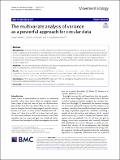Files in this item
The multivariate analysis of variance as a powerful approach for circular data
Item metadata
| dc.contributor.author | Landler, Lukas | |
| dc.contributor.author | Ruxton, Graeme D. | |
| dc.contributor.author | Malkemper, E. Pascal | |
| dc.date.accessioned | 2022-05-13T14:30:11Z | |
| dc.date.available | 2022-05-13T14:30:11Z | |
| dc.date.issued | 2022-04-27 | |
| dc.identifier | 279307190 | |
| dc.identifier | 56d08e94-ea1a-43c3-819f-c1c971aaeef9 | |
| dc.identifier | 85128961645 | |
| dc.identifier | 000788305600001 | |
| dc.identifier.citation | Landler , L , Ruxton , G D & Malkemper , E P 2022 , ' The multivariate analysis of variance as a powerful approach for circular data ' , Movement Ecology , vol. 10 , 21 . https://doi.org/10.1186/s40462-022-00323-8 | en |
| dc.identifier.issn | 2051-3933 | |
| dc.identifier.other | RIS: urn:26F57E58FD3DD0AEDFD8A4DF1B79D7E4 | |
| dc.identifier.other | RIS: Landler2022 | |
| dc.identifier.other | ORCID: /0000-0001-8943-6609/work/112333588 | |
| dc.identifier.uri | https://hdl.handle.net/10023/25369 | |
| dc.description | LL is supported by the Austrian Science Fund (FWF, Grant Number: P32586). EPM receives funding from the European Research Council (ERC) under the European Union’s Horizon 2020 research and innovation program (Grant Agreement No. 948728). | en |
| dc.description.abstract | Background A broad range of scientific studies involve taking measurements on a circular, rather than linear, scale (often variables related to times or orientations). For linear measures there is a well-established statistical toolkit based on linear modelling to explore the associations between this focal variable and potentially several explanatory factors and covariates. In contrast, statistical testing of circular data is much simpler, often involving either testing whether variation in the focal measurements departs from circular uniformity, or whether a single explanatory factor with two levels is supported. Methods We use simulations and example data sets to investigate the usefulness of a MANOVA approach for circular data in comparison to commonly used statistical tests. Results Here we demonstrate that a MANOVA approach based on the sines and cosines of the circular data is as powerful as the most-commonly used tests when testing deviation from a uniform distribution, while additionally offering extension to multi-factorial modelling that these conventional circular statistical tests do not. Conclusions The herein presented MANOVA approach offers a substantial broadening of the scientific questions that can be addressed statistically using circular data. | |
| dc.format.extent | 10 | |
| dc.format.extent | 2781333 | |
| dc.language.iso | eng | |
| dc.relation.ispartof | Movement Ecology | en |
| dc.subject | MANOVA | en |
| dc.subject | Rayleigh test | en |
| dc.subject | Directional data | en |
| dc.subject | Orientation | en |
| dc.subject | Periodicity | en |
| dc.subject | HA Statistics | en |
| dc.subject | DAS | en |
| dc.subject.lcc | HA | en |
| dc.title | The multivariate analysis of variance as a powerful approach for circular data | en |
| dc.type | Journal article | en |
| dc.contributor.institution | University of St Andrews. School of Biology | en |
| dc.contributor.institution | University of St Andrews. Centre for Biological Diversity | en |
| dc.contributor.institution | University of St Andrews. Institute of Behavioural and Neural Sciences | en |
| dc.identifier.doi | 10.1186/s40462-022-00323-8 | |
| dc.description.status | Peer reviewed | en |
This item appears in the following Collection(s)
Items in the St Andrews Research Repository are protected by copyright, with all rights reserved, unless otherwise indicated.

